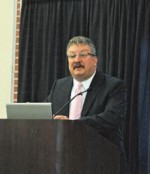Summit explores University diversity

The University’s latest graduating class represented 102 countries and more than 40 states – and recent grads ranged in age from 19 to 79 years old.
The broad range of ages and origins was just one topic of discussion at the fourth annual Diversity Summit held Friday at USF. The aim of the summit was to educate the invited executive leaders, deans and directors on the best ways to enhance student and faculty success.
USF President Judy Genshaft set the stage by describing diversity as “something that makes the world go round.”
Ted Williams, associate vice president of Diversity and Equal Opportunity at USF, delivered opening remarks before introducing the keynote speaker, Luis Vazquez.
Williams said the University continues to increase its enrollment of underrepresented minorities. He did note the challenge of maintaining Native Americans in graduate programs, which he said was a problem not unique to USF. Williams also said there was a drop in black medical students due to a decrease in viable applicants, stiffer competition and better financial aid packages at other universities.
Vazquez began his presentation by explaining his aversion to the term “students at risk.” Having been considered one as a child, Vazquez said he believes that these students have potential and promise, but have been limited by their environments. Furthermore, he said that teachers are too lazy to do their jobs and place the burden on students.
The Summit also featured a student panel in which students discussed their experiences with diversity. These students were Faran Abbasi, Avi-Anne Richardson, Victor Velasco, Blair Henderson, Walter Walker, Janette McDonald and Jael Rodriguez. There was a non-traditional aged student, a first-year medical student, a Jamaican-born football player and a dyslexic accounting major.
Each student’s story came back to the same point: USF is very diverse. Janette McDonald, the non-traditional student, said of diversity: “It’s just not color.”
Victor Velasco explained that having a non-black student in the Black Student Union (BSU) illustrates a move toward diversity.
Ultimately, the Summit argued that the University is a culturally diverse environment that requires sensitivity and understanding to prepare students to face a world which is becoming smaller and smaller each day.





